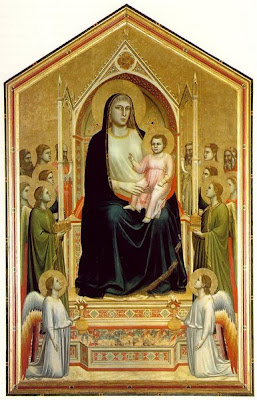 |
| The Kiss by Gustav Klimt, 1907-8, Vienna. |
It was a highly unusual artistic convention for a time period known as "The Decadence," but The Kiss remarkably resurrects a rather ancient means of depicting the immortal soul, the Garden of Eden and humanity's destiny.
 |
| Ognissanti Madonna, Giotto, about 1310, Florence. |
Giotto excelled at religious art and The Ognissanti Madonna perfectly illustrates the icon style using Gold leafing which Klimt utilized for The Kiss. Because gold is the most valuable material known to man, it perfectly translates to the immaterial value and wealth of the soul, because the soul is immortal, and gives us the very image of God Himself within us.
 |
| The background on the left side appears like a shimmering of gold, whereas on the right side, the paint brush's strokes can be seen, it appears "blocky," mirroring the "blocks" on the man's robe. |
For The Kiss, let's begin with the background. Behind the head of the man and woman is a blank space of gold leaf, not as bright as the bodies of the couple, but still abstract. Next, the small "pasture" or "meadow" area they are on. The flowers supposedly denote growth and health, but there is also a cliff, and the woman is precariously close to it. Off of the woman's body--and not the man's--specifically from her legs down, are golden ribbons, or necklaces, bracelets perhaps, but golden ornaments, "like a bride bedecked with jewels." The woman's "gown" is ornamental, that is, she doesn't have a "real" body, rather like the figures in Giotto's work or earlier Medieval icnography, it's abstracted. Her gown, however, describes more about her state of soul than a realistic portrait could: with bright flowers scattered over the gold, she is a virtuous maiden.
 |
Adele Bloch-Bauer I, 1907, Neue Gallerie, New York. In 2006, it was purchased for $135 million making it up to that point, the most expensive painting ever sold. |
 |
| Judith With the Head of Holofernes. |
Likewise, examining Klimt's earliest work in this style, Judith with the Head of Holofernes of 1901, really underlines the use of dark colors by the artist to literally comunicate "something dark." In the final examination of the man and the woman in The Kiss, it seems that she is about to "fall" off that cliff because of his dark desires for her. The faint blocks painted within the background behind the woman is literally in the background that if she is not careful, the man will bring his sin onto her; conversely, the woman's purity is within the background behind the man, suggesting that the exercising of her virtue can bring the parts of his soul dead in sin back to life. But the most important thing about the work is the title: The Kiss, because there is no kiss, he's biting her, or feeding on her, like a vampire, and this is what's so important about their dynamic, and the entire point of the painting.
 |
| The Kiss of Judas, the Arena Chapel, circa 1305. |
When God created Adam, He breathed life into him; in effect, God kissed Adam. In the divine economy of salvation, when Judas kissed Christ to betray Him, Judas symbolically took life away from Christ. When Christ appeared to the Apostles, he breathed on them, to return that Holy Spirit to them, and when, at Pentecost, the Apostles heard the great wind and then there were tongues as if of fire, that was the Holy Spirit kissing them, the Mouth that gives Life.
These historical occurences within the History of Salvation makes the kiss important (think also of Sts. Anne and Joachim at the Golden Gate). When a man and woman kiss, they impart their own life to each other, and for that reason, the convenant of a marriage is sealed with a kiss, the breath of life they each give to the other.

The Kiss, then, is a breath of life that isn't happening. When, in the Garden of Eden, God gave Eve to be Adam's help mate, and then the serpent tempted her, women have gotten a bad rap ever since. But if the help mate is ruined, that means the one she was supposed to help is ruined, too, and it seems that it's this state of ruin and not being able to get out of it which Klimt depicts, and realized because of his own life. Although he was still living with his parents and two unmarried sisters when he was 45, he had already fathered 3 children out of wedlock: The Kiss seems to be his great warning to every woman, not just about his own "dark desires," but about those of every man. The poor girl seems to be so trusting, and she shouldn't be. The woman is seen in her idealized state, and within moments, if the man has his way with her, she will fall over that (spiritual) cliff into ruin. Klimt seems to be sending out a signal for help, that woman must be chaste and very aware of how unchaste men are by nature of their desires.
Although men want women to give into their sexual appetites, women must resist them to save themselves and men.



0 comments:
Post a Comment